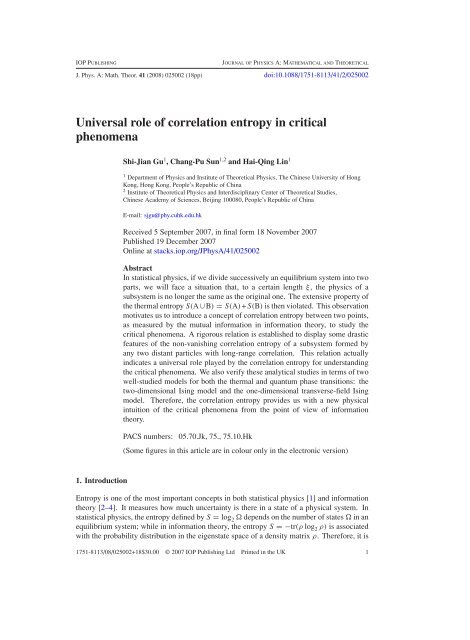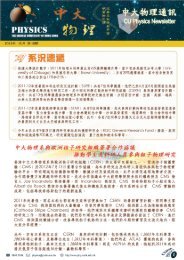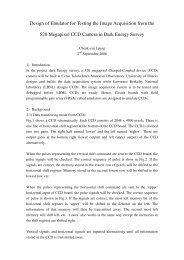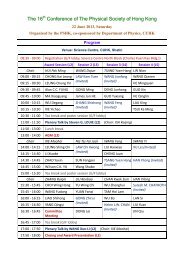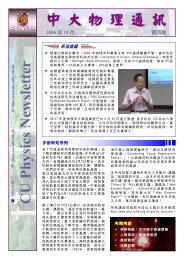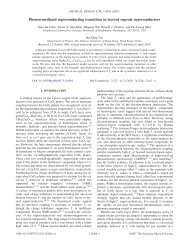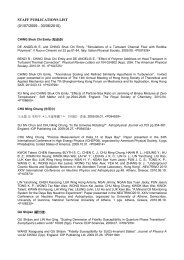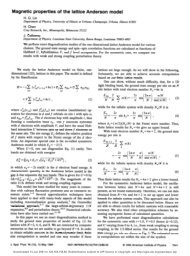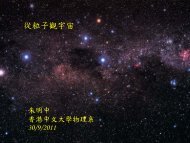Universal role of correlation entropy in critical phenomena
Universal role of correlation entropy in critical phenomena
Universal role of correlation entropy in critical phenomena
Create successful ePaper yourself
Turn your PDF publications into a flip-book with our unique Google optimized e-Paper software.
IOP PUBLISHING<br />
JOURNAL OF PHYSICS A: MATHEMATICAL AND THEORETICAL<br />
J. Phys. A: Math. Theor. 41 (2008) 025002 (18pp) doi:10.1088/1751-8113/41/2/025002<br />
<strong>Universal</strong> <strong>role</strong> <strong>of</strong> <strong>correlation</strong> <strong>entropy</strong> <strong>in</strong> <strong>critical</strong><br />
<strong>phenomena</strong><br />
Shi-Jian Gu 1 , Chang-Pu Sun 1,2 and Hai-Q<strong>in</strong>g L<strong>in</strong> 1<br />
1 Department <strong>of</strong> Physics and Institute <strong>of</strong> Theoretical Physics, The Ch<strong>in</strong>ese University <strong>of</strong> Hong<br />
Kong, Hong Kong, People’s Republic <strong>of</strong> Ch<strong>in</strong>a<br />
2 Institute <strong>of</strong> Theoretical Physics and Interdiscipl<strong>in</strong>ary Center <strong>of</strong> Theoretical Studies,<br />
Ch<strong>in</strong>ese Academy <strong>of</strong> Sciences, Beij<strong>in</strong>g 100080, People’s Republic <strong>of</strong> Ch<strong>in</strong>a<br />
E-mail: sjgu@phy.cuhk.edu.hk<br />
Received 5 September 2007, <strong>in</strong> f<strong>in</strong>al form 18 November 2007<br />
Published 19 December 2007<br />
Onl<strong>in</strong>e at stacks.iop.org/JPhysA/41/025002<br />
Abstract<br />
In statistical physics, if we divide successively an equilibrium system <strong>in</strong>to two<br />
parts, we will face a situation that, to a certa<strong>in</strong> length ξ, the physics <strong>of</strong> a<br />
subsystem is no longer the same as the orig<strong>in</strong>al one. The extensive property <strong>of</strong><br />
the thermal <strong>entropy</strong> S(A∪B) = S(A)+S(B) is then violated. This observation<br />
motivates us to <strong>in</strong>troduce a concept <strong>of</strong> <strong>correlation</strong> <strong>entropy</strong> between two po<strong>in</strong>ts,<br />
as measured by the mutual <strong>in</strong>formation <strong>in</strong> <strong>in</strong>formation theory, to study the<br />
<strong>critical</strong> <strong>phenomena</strong>. A rigorous relation is established to display some drastic<br />
features <strong>of</strong> the non-vanish<strong>in</strong>g <strong>correlation</strong> <strong>entropy</strong> <strong>of</strong> a subsystem formed by<br />
any two distant particles with long-range <strong>correlation</strong>. This relation actually<br />
<strong>in</strong>dicates a universal <strong>role</strong> played by the <strong>correlation</strong> <strong>entropy</strong> for understand<strong>in</strong>g<br />
the <strong>critical</strong> <strong>phenomena</strong>. We also verify these analytical studies <strong>in</strong> terms <strong>of</strong> two<br />
well-studied models for both the thermal and quantum phase transitions: the<br />
two-dimensional Is<strong>in</strong>g model and the one-dimensional transverse-field Is<strong>in</strong>g<br />
model. Therefore, the <strong>correlation</strong> <strong>entropy</strong> provides us with a new physical<br />
<strong>in</strong>tuition <strong>of</strong> the <strong>critical</strong> <strong>phenomena</strong> from the po<strong>in</strong>t <strong>of</strong> view <strong>of</strong> <strong>in</strong>formation<br />
theory.<br />
PACS numbers: 05.70.Jk, 75., 75.10.Hk<br />
(Some figures <strong>in</strong> this article are <strong>in</strong> colour only <strong>in</strong> the electronic version)<br />
1. Introduction<br />
Entropy is one <strong>of</strong> the most important concepts <strong>in</strong> both statistical physics [1] and <strong>in</strong>formation<br />
theory [2–4]. It measures how much uncerta<strong>in</strong>ty is there <strong>in</strong> a state <strong>of</strong> a physical system. In<br />
statistical physics, the <strong>entropy</strong> def<strong>in</strong>ed by S = log 2 depends on the number <strong>of</strong> states <strong>in</strong> an<br />
equilibrium system; while <strong>in</strong> <strong>in</strong>formation theory, the <strong>entropy</strong> S =−tr(ρ log 2 ρ) is associated<br />
with the probability distribution <strong>in</strong> the eigenstate space <strong>of</strong> a density matrix ρ. Therefore, it is<br />
1751-8113/08/025002+18$30.00 © 2007 IOP Publish<strong>in</strong>g Ltd Pr<strong>in</strong>ted <strong>in</strong> the UK 1
J. Phys. A: Math. Theor. 41 (2008) 025002 S-J Gu et al<br />
very <strong>in</strong>terest<strong>in</strong>g to look <strong>in</strong>to some fundamental issues from different po<strong>in</strong>ts <strong>of</strong> view due to the<br />
common ground <strong>of</strong> two fields.<br />
In statistical physics, if we divide an equilibrium system <strong>in</strong>to a large number <strong>of</strong><br />
macroscopic parts, the total number <strong>of</strong> state <strong>in</strong> the phase space is a product <strong>of</strong> the number <strong>of</strong><br />
state ω i <strong>of</strong> each part, i.e. = ∏ i ω i. This precondition leads to the fact that the <strong>entropy</strong> is an<br />
extensive quantity <strong>in</strong> statistical physics, i.e. S = ∑ i S i, which is one <strong>of</strong> the bases <strong>of</strong> the second<br />
law <strong>of</strong> the thermodynamics. However, a realistic system <strong>in</strong>cludes all k<strong>in</strong>ds <strong>of</strong> <strong>in</strong>teractions,<br />
and the dynamics at one site is no longer <strong>in</strong>dependent <strong>of</strong> other sites nearby. This fact implies<br />
that if we successively divide a system <strong>in</strong>to two parts, we will face a situation that, to a certa<strong>in</strong><br />
length ξ, the physics <strong>of</strong> a subsystem is no longer the same as the orig<strong>in</strong>al one. The length<br />
ξ actually def<strong>in</strong>es a characteristic scale for the statistical physics, and physicists usually call<br />
it <strong>correlation</strong> length <strong>in</strong> studies <strong>of</strong> different k<strong>in</strong>ds <strong>of</strong> <strong>correlation</strong> functions. From the po<strong>in</strong>t <strong>of</strong><br />
view <strong>of</strong> <strong>in</strong>formation theory, for two subsystems A and B with<strong>in</strong> the length scale ξ, they are no<br />
longer <strong>in</strong>dependent <strong>of</strong> each other, and their <strong>entropy</strong> does not satisfy the extensive property 3 ,<br />
i.e., S(A ∪ B) ≠ S(A) + S(B).<br />
On the other hand, the <strong>correlation</strong> function plays a fundamental <strong>role</strong> <strong>in</strong> physics. Almost<br />
all physical quantities, not only <strong>in</strong> condensed matter physics but also <strong>in</strong> quantum field theory,<br />
are related to the <strong>correlation</strong> function. Thus, it devotes to understand<strong>in</strong>g many <strong>phenomena</strong><br />
<strong>in</strong> quantum mechanics. Physically, the <strong>correlation</strong> function denotes the amplitude <strong>of</strong> the<br />
dependence <strong>of</strong> physical variables between two po<strong>in</strong>ts <strong>in</strong> spacetime. From the po<strong>in</strong>t <strong>of</strong> view<br />
<strong>of</strong> <strong>in</strong>formation theory, it also partially measures how much uncerta<strong>in</strong>ty <strong>of</strong> a physical quantity<br />
is at one location if the quantity at another location is given. However, this uncerta<strong>in</strong>ty still<br />
depends on the quantity itself. For example, <strong>in</strong> the quantum system, the diagonal <strong>correlation</strong><br />
function usually differs from the <strong>of</strong>f-diagonal <strong>correlation</strong> function. Therefore, <strong>in</strong> order to learn<br />
the dependence between two separated systems, it is important to ask such a question: to what<br />
extent the equality S(A∪B) = S(A)+S(B) is violated. This question <strong>in</strong>troduces an important<br />
concept <strong>in</strong> <strong>in</strong>formation theory, i.e., the mutual <strong>in</strong>formation, which is def<strong>in</strong>ed as<br />
S(A|B) = S(A) + S(B) − S(A ∪ B), (1)<br />
where S(i) =−tr(ρ i log 2 ρ i ), i = A, B, A ∪ B is the <strong>entropy</strong> <strong>of</strong> the correspond<strong>in</strong>g reduced<br />
density matrix. If ρ is classical, it is the Shannon <strong>entropy</strong> [2]; otherwise it is the von<br />
Neumann <strong>entropy</strong> [5] <strong>of</strong> quantum <strong>in</strong>formation theory. Actually, all <strong>correlation</strong> functions<br />
〈O A O B 〉 between subsystems A and B can be calculated from the reduced density matrix<br />
ρ A∪B , i.e., 〈O A O B 〉=tr〈O A O B ρ A∪B 〉. The mutual <strong>in</strong>formation, which measures the common<br />
shared <strong>in</strong>formation, def<strong>in</strong>es a more general operator-<strong>in</strong>dependent <strong>correlation</strong> between two<br />
subsystems. Tak<strong>in</strong>g <strong>in</strong>to account the <strong>role</strong> <strong>of</strong> <strong>entropy</strong> <strong>in</strong> the statistical physics, we would like<br />
to call it <strong>correlation</strong> <strong>entropy</strong> hereafter.<br />
To have a concrete <strong>in</strong>terpretation, let us resort to the orig<strong>in</strong>al understand<strong>in</strong>g <strong>of</strong> the <strong>entropy</strong>.<br />
In <strong>in</strong>formation theory, the <strong>entropy</strong> is used to quantify the physical resource (<strong>in</strong> units <strong>of</strong><br />
classical bit due to log 2 <strong>in</strong> its expression) needed to store <strong>in</strong>formation. For example, <strong>in</strong> the<br />
exact diagonalization approach, if we want to diagonalize a Hamiltonian <strong>of</strong> 10-site sp<strong>in</strong>-1<br />
cha<strong>in</strong> and no symmetry can be used to reduce the dimension <strong>of</strong> its Hilbert space, we need at<br />
least S = log 2 3 10 = 10 log 2 3 bits to store a basis. Therefore, the <strong>correlation</strong> <strong>entropy</strong> actually<br />
measures the additional physical resource required if we store two subsystems, respectively,<br />
rather than store them together. As a simple example, let us consider a two-qubit system <strong>in</strong> a<br />
s<strong>in</strong>glet state (|↑↓〉 − |↓↑〉)/ √ 2, we have S(A) = 1,S(B) = 1,S(A ∪ B) = 0, which leads to<br />
S(A|B) = 2. Obviously, there is no <strong>in</strong>formation <strong>in</strong> a given s<strong>in</strong>glet state. However, each sp<strong>in</strong><br />
<strong>in</strong> this state is completely uncerta<strong>in</strong>. So we need two bits to store them respectively. On the<br />
3 In <strong>in</strong>formation theory ‘extensivity’ property <strong>of</strong> the mutual <strong>entropy</strong> is usually called ‘additivity’<br />
2
J. Phys. A: Math. Theor. 41 (2008) 025002 S-J Gu et al<br />
other hand, the <strong>correlation</strong> <strong>entropy</strong> is simply twice the entanglement, as measured by partial<br />
<strong>entropy</strong>, between two systems because <strong>of</strong> S(A) = S(B) for a pure state. The reason why we<br />
<strong>in</strong>terpret the <strong>correlation</strong> <strong>entropy</strong> <strong>in</strong> this way is that besides the quantum <strong>correlation</strong> the state<br />
also has classical <strong>correlation</strong> [6]. From this po<strong>in</strong>t <strong>of</strong> view, the <strong>correlation</strong> <strong>entropy</strong> is just a<br />
measure <strong>of</strong> total <strong>correlation</strong>, <strong>in</strong>clud<strong>in</strong>g the quantum and classical <strong>correlation</strong>s, between two<br />
subsystems. They go halves with each other <strong>in</strong> <strong>correlation</strong> <strong>entropy</strong> for the pure state. For a<br />
mixed state, the <strong>correlation</strong> <strong>entropy</strong> also measures the amount <strong>of</strong> the uncerta<strong>in</strong>ty <strong>of</strong> one system<br />
before we learn one from another. From the above <strong>in</strong>terpretations, it is then not surpris<strong>in</strong>g that<br />
the <strong>correlation</strong> <strong>entropy</strong> fails to measure the entanglement [7].<br />
In the statistical physics, the <strong>critical</strong> <strong>phenomena</strong> are the central topic. To have a complete<br />
understand<strong>in</strong>g on the <strong>critical</strong> behavior, various methods, such as renormalization group [8],<br />
Monte–Carlo simulation [9] and mean-field approach, etc, have been developed and applied to<br />
many k<strong>in</strong>ds <strong>of</strong> systems. In recent years, the study on the <strong>role</strong> <strong>of</strong> entanglement [10–15]aswell<br />
as the quantum mutual <strong>in</strong>formation [16] <strong>in</strong> the quantum <strong>critical</strong> behavior [17] has established<br />
a bridge between quantum <strong>in</strong>formation theory and condensed matter physics, and sheds new<br />
light on the quantum phase transitions due to its <strong>in</strong>terest<strong>in</strong>g behavior around the <strong>critical</strong> po<strong>in</strong>t.<br />
However, the entanglement is fragile under the thermal fluctuation and can be suppressed to<br />
zero at f<strong>in</strong>ite temperatures. Then it is difficult to witness a generalized thermal phase transition<br />
<strong>in</strong> terms <strong>of</strong> quantum entanglement.<br />
In this paper, we will study the <strong>role</strong> <strong>of</strong> the <strong>correlation</strong> <strong>entropy</strong> <strong>in</strong> both thermal and<br />
quantum phase transitions. Like the fundamental <strong>role</strong> <strong>of</strong> the two-po<strong>in</strong>t <strong>correlation</strong> function<br />
<strong>in</strong> the statistical physics, we are <strong>in</strong>terested <strong>in</strong> the universal <strong>role</strong> played by the two-po<strong>in</strong>t<br />
<strong>correlation</strong> <strong>entropy</strong> <strong>in</strong> <strong>critical</strong> <strong>phenomena</strong>. The paper is organized as follows. In section 2,<br />
for a pedagogical purpose, we study a toy model, i.e., the Heisenberg dimer, and show that<br />
the thermal <strong>entropy</strong> is not an extensive parameter <strong>in</strong> such a simple system. In section 3, we<br />
discuss the relation between the reduced density matrix, the long-range <strong>correlation</strong> and the<br />
<strong>correlation</strong> <strong>entropy</strong>. In section 4, we study the properties <strong>of</strong> the <strong>correlation</strong> <strong>entropy</strong> <strong>in</strong> thermal<br />
phase transition, as illustrated by the classical two-dimensional Is<strong>in</strong>g model. In section 5, we<br />
study the properties <strong>of</strong> the <strong>correlation</strong> <strong>entropy</strong> <strong>in</strong> a simple quantum phase transition <strong>of</strong> the<br />
one-dimensional transverse-field Is<strong>in</strong>g model. In section 6, some discussions and prospects<br />
are presented. F<strong>in</strong>ally, a brief summary is given <strong>in</strong> section 7.<br />
2. A toy model: Heisenberg dimer<br />
For a pedagogical purpose and mak<strong>in</strong>g our motivation more clear, we first have a look at a toy<br />
model: Heisenberg dimer, whose Hamiltonian reads<br />
H = σ 1 · σ 2 , (2)<br />
where σ i (σ x ,σ y ,σ z ) are Pauli matrices at site i,<br />
( ) 0 1<br />
σ x = , σ y =<br />
1 0<br />
( 0 −i<br />
i 0<br />
)<br />
( ) 1 0<br />
, σ z =<br />
0 −1<br />
and the coupl<strong>in</strong>g between the two sites is set to unit for simplicity. The Hamiltonian can be<br />
diagonalized easily. Its ground state is a sp<strong>in</strong> s<strong>in</strong>glet state<br />
0 = 1 √<br />
2<br />
[|↑↓〉 − |↓↑〉] , (4)<br />
with eigenvalue E 0 =−3, while three degenerate excited states are<br />
1 = 1 √<br />
2<br />
[|↑↓〉 + |↓↑〉], 2 = |↑↑〉, 3 =|↓↓〉, (5)<br />
(3)<br />
3
J. Phys. A: Math. Theor. 41 (2008) 025002 S-J Gu et al<br />
with higher eigenvalue E 1,2,3 = 1. Therefore, accord<strong>in</strong>g to the statistical physics, the thermal<br />
<strong>entropy</strong> <strong>of</strong> the system vanishes at zero temperature. When the system is contacted with a<br />
thermal bath with temperature T, the thermal state <strong>of</strong> the system is described by a density<br />
matrix<br />
⎛<br />
⎞<br />
e −2/T 0 0 0<br />
0 cosh(2/T) − s<strong>in</strong>h(2/T) 0<br />
ρ = ζ<br />
⎜<br />
⎝ 0 − s<strong>in</strong>h(2/T) cosh(2/T) 0<br />
⎟<br />
(6)<br />
⎠<br />
0 0 0 e −2/T<br />
where<br />
1<br />
ζ =<br />
. (7)<br />
3e −2/T +e2/T Because <strong>of</strong> SU(2) symmetry <strong>of</strong> the Heisenberg dimer, the s<strong>in</strong>gle-site <strong>entropy</strong> S(i)<strong>of</strong> the system<br />
is always unity, and the <strong>entropy</strong> <strong>of</strong> the whole system is<br />
S(1 ∪ 2) = log 2 (3e−4/T +1)<br />
+ 3log 2 (3+e4/T )<br />
. (8)<br />
3e −4/T +1 3+e 4/T<br />
Then we can see that S(1 ∪ 2) ≠ S(1) + S(2) both at zero and f<strong>in</strong>ite temperatures. In the<br />
high-temperature limit, the asymptotic behavior <strong>of</strong> the <strong>correlation</strong> <strong>entropy</strong> is S(1|2) ∝ 1/T 2 .<br />
So only when T →∞,S(1|2) → 0, the extensive property then holds. The physics beh<strong>in</strong>d<br />
this fact is quite clear. It is the <strong>in</strong>teraction between the two sites that establishes a k<strong>in</strong>d <strong>of</strong><br />
<strong>correlation</strong> and then breaks the extensive property <strong>of</strong> the <strong>entropy</strong>.<br />
For a large system, however, the <strong>correlation</strong> <strong>entropy</strong> usually decays with the <strong>in</strong>creas<strong>in</strong>g<br />
<strong>of</strong> distance between the two parts, and the <strong>entropy</strong> becomes an extensive quantity beyond the<br />
characteristic scale. Only around the <strong>critical</strong> po<strong>in</strong>t where a phase transition occurs, does the<br />
system behave like a whole and cannot be divided <strong>in</strong>to two parts, and then the <strong>correlation</strong><br />
<strong>entropy</strong> has long-range behavior.<br />
3. Reduced density matrix, long-range order and <strong>correlation</strong> <strong>entropy</strong><br />
In many-body physics, the reduced density matrices <strong>of</strong> a one- and two-body subsystem can<br />
be, <strong>in</strong> general, written as<br />
〈µ ′ |ρ i |µ〉 =tr ( a iµ ′ρa † iµ)<br />
, 〈µ ′ ν ′ |ρ i∪j |µν〉 =tr ( a iµ ′a jν ′ρa † jν a† iµ)<br />
, (9)<br />
respectively. Here, a iµ ,a jν are annihilation operators for states |µ〉, |ν〉 localized at site i, j,<br />
respectively, and satisfy the commutation (anti-commutation) relation for bosonic (fermionic)<br />
states. The reduced density matrices are usually normalized as<br />
tr(ρ i ) = 1, tr(ρ i∪j ) = 1, (10)<br />
so that one has a probability explanation for their diagonal elements <strong>in</strong> the correspond<strong>in</strong>g<br />
eigenstate space.<br />
In the sp<strong>in</strong> system, the reduced density matrix <strong>of</strong> a s<strong>in</strong>gle sp<strong>in</strong> at position i takes the form<br />
( 〈 〉<br />
ρ i = 1 2 1+ σ<br />
x<br />
i σ<br />
x<br />
i + 〈 σ y 〉<br />
y<br />
i σ<br />
i<br />
+ 〈 σ z 〉 )<br />
i σ<br />
z<br />
i . (11)<br />
For two arbitrary sp<strong>in</strong>s at positions i and j, the two-site reduced density matrix generally takes<br />
the form<br />
ρ i∪j = 1 4 + 1 ∑ (〈<br />
µ<br />
〉<br />
µ σ<br />
i σ<br />
i<br />
+ 〈 σ µ 〉<br />
µ<br />
) 1 ∑ 〈<br />
µ<br />
j σ<br />
j + σ<br />
i<br />
σ ν 〉<br />
µ<br />
j σ<br />
i<br />
σj ν 4<br />
4<br />
. (12)<br />
4<br />
µ<br />
µν
J. Phys. A: Math. Theor. 41 (2008) 025002 S-J Gu et al<br />
Obviously, under some symmetry, the above reduced density matrix can be simplified.<br />
For example, if the state <strong>of</strong> N sp<strong>in</strong>s is also an eigenstate <strong>of</strong> z-component <strong>of</strong> total sp<strong>in</strong>s<br />
S z = ∑ S z i<br />
= 0 and possesses the exchange symmetry, then equation (12) can be simplified<br />
as<br />
⎛<br />
u + ⎞<br />
0 0 0<br />
ρ i∪j = ⎜<br />
0 w 1 z 0<br />
⎟<br />
⎝ 0 z ∗ w 2 0 ⎠ (13)<br />
0 0 0 u −<br />
<strong>in</strong> the basis <strong>of</strong> σ z<br />
i σ z j<br />
: {|↑↑〉, |↑↓〉, |↓↑〉, |↓↓〉}. Here, the matrix elements can be calculated<br />
from the <strong>correlation</strong> functions<br />
u + = u − = 1 ( 〈<br />
4 1+ σ<br />
z<br />
i σ z 〉)<br />
j ,<br />
( 〈<br />
w 1 = w 2 = 1 4 1 − σ<br />
z<br />
i σ z 〉)<br />
j ,<br />
(14)<br />
z = 1 (〈<br />
4 σ<br />
x<br />
i σj<br />
x 〉 〈<br />
y + σ<br />
i σ y 〉)<br />
j .<br />
With the help <strong>of</strong> the Jordan–Schw<strong>in</strong>ger mapp<strong>in</strong>g [18],<br />
σ j + = a† j↑ a j↓, σ − j<br />
= a † j↓ a j↑, σ z j = ( a † j↑ a j↑ − a † j↓ a )<br />
j↓<br />
where a † jµ<br />
stands for the pseudo fermionic creation operator for s<strong>in</strong>gle-particle state |j,µ〉 at<br />
position j; the element <strong>in</strong> the reduced density matrix (12) can be reexpressed <strong>in</strong> the form <strong>of</strong><br />
equation (9). For example,<br />
〈<br />
σ<br />
+<br />
i σ − 〉 〈<br />
j =− a<br />
†<br />
i↑ a† j↓ a 〉<br />
i↓a j↑ . (16)<br />
Therefore, we can explore the property <strong>of</strong> long-range <strong>correlation</strong> <strong>in</strong> the sp<strong>in</strong> system through<br />
pseudo fermion systems.<br />
We first consider the long-range <strong>correlation</strong> <strong>in</strong> classical systems, e.g. Is<strong>in</strong>g model, <strong>in</strong><br />
which the reduced density matrices take the diagonal form, i.e.<br />
〈µ ′ |ρ i |µ〉 =δ µ ′ µ tr ( a iµ ′ρa<br />
iµ) † ,<br />
〈µ ′ ν ′ |ρ i∪j |µν〉 =δ µ ′ µδ ν ′ ν tr ( a iµ ′a jν ′ρa † ) (17)<br />
jν a† iµ .<br />
Then, if there is no long-range <strong>correlation</strong><br />
〈µν|ρ i∪j |µν〉 =tr ( a † jν a† iµ a iµa jν ρ ) ,<br />
= 〈 a † jν a† iµ a 〉<br />
iµa jν ,<br />
→ 〈 a † iµ a 〉〈<br />
iµ a<br />
†<br />
jν a jν〉<br />
, (18)<br />
for |i − j| →∞, the two-site <strong>entropy</strong> becomes<br />
where<br />
(15)<br />
S(i ∪ j) → S(i) + S(j), (19)<br />
S(l) =− ∑ ν<br />
〈<br />
a<br />
†<br />
lν a 〉 〈<br />
lν log2 a<br />
†<br />
lν a lν〉<br />
, l = i, j, (20)<br />
where the normalization conditions <strong>of</strong> ρ i(j) and ρ i∪j have been used. Obviously, we have<br />
S(i|j) = 0, which means that if there is no long-range <strong>correlation</strong>, the <strong>correlation</strong> <strong>entropy</strong><br />
vanishes at a long distance.<br />
On the other hand, if there exists long-range <strong>correlation</strong>, for example,<br />
G iµ,jν ≡〈n iµ n jν 〉−〈n iµ 〉〈n jν 〉=C, (21)<br />
5
J. Phys. A: Math. Theor. 41 (2008) 025002 S-J Gu et al<br />
for |i − j| →∞and a nonzero C, then<br />
S(i|j) > 0. (22)<br />
Now we study the <strong>correlation</strong> <strong>entropy</strong> <strong>in</strong> quantum systems, <strong>in</strong> which the reduced density<br />
matrix usually is not diagonal. Then, if the system does not have long-range <strong>correlation</strong>,<br />
〈µ ′ ν ′ |ρ i∪j |µν〉 = 〈 a † iµ a iµ ′ 〉〈<br />
a<br />
†<br />
jν a jν ′ 〉<br />
, (23)<br />
for |i − j| →∞, the reduced density matrix can be written <strong>in</strong>to a direct product form, i.e.<br />
ρ i∪j = ρ i ⊗ ρ j . (24)<br />
Then the reduced density matrices ρ i ,ρ j can be diagonalized <strong>in</strong> their own subspace. So <strong>in</strong><br />
pr<strong>in</strong>ciple, we can have ρ i = ∑ µ p µ|ϕ µ 〉 ii 〈ϕ µ |, and ρ j = ∑ ν p ν|ϕ ν 〉 jj 〈ϕ ν |, where p µ ,p ν are<br />
the probability distributions for ρ i and ρ j , respectively. As we have done for the classical<br />
system, we then have<br />
S(i|j) = S(ρ i ) + S(ρ j ) − S(ρ i∪j ) = 0. (25)<br />
In order to study its relation to the long-range <strong>correlation</strong>, now we express the <strong>correlation</strong><br />
<strong>entropy</strong> <strong>in</strong> terms <strong>of</strong> the relative <strong>entropy</strong> [19]<br />
S(i|j) = tr(ρ i∪j log 2 ρ i∪j ) − tr(ρ i∪j log 2 ρ i ⊗ ρ j ) (26)<br />
between the whole system and the direct product form <strong>of</strong> two subsystems where (ρ i ⊗<br />
ρ j ) µν,µ ′ ν ′ = 〈 a † iµ a iµ ′ 〉〈<br />
a<br />
†<br />
jν a jν ′ 〉<br />
. Then if there exists a long-range <strong>correlation</strong>, such as<br />
〈µ ′ ν ′ |ρ ij |µν〉 = 〈 a † iµ a iµ ′ 〉〈<br />
a<br />
†<br />
jν a jν ′ 〉<br />
+ C, (27)<br />
for |i − j| →∞and a nonzero C, it can be proved that [20]<br />
S(i|j) > 0. (28)<br />
In quantum <strong>in</strong>formation theory, <strong>in</strong>equality (28) is called Kle<strong>in</strong> <strong>in</strong>equality [20]. Therefore,<br />
the existence <strong>of</strong> the long-range <strong>correlation</strong> will lead to a positive <strong>correlation</strong> <strong>entropy</strong> (28).<br />
This observation is very important <strong>in</strong> understand<strong>in</strong>g <strong>critical</strong> <strong>phenomena</strong>. Accord<strong>in</strong>g to the<br />
theory <strong>of</strong> phase transitions, the presence <strong>of</strong> the long-range <strong>correlation</strong> is crucial. However,<br />
different phase transitions depend on the different long-range <strong>correlation</strong>s. For example, <strong>in</strong><br />
the superfluid phase <strong>of</strong> 4 He, the <strong>of</strong>f-diagonal-long-range order, as suggested by Yang [21], is<br />
necessary; while <strong>in</strong> another k<strong>in</strong>d <strong>of</strong> condensate <strong>of</strong> exciton, it may require a diagonal-longrange<br />
<strong>correlation</strong> [22]. Then the above results show that the non-vanish<strong>in</strong>g positive-def<strong>in</strong>ed<br />
<strong>correlation</strong> <strong>entropy</strong> is a universal and necessary condition for general <strong>critical</strong> <strong>phenomena</strong> 4 .<br />
4. Thermal phase transition: the two-dimensional Is<strong>in</strong>g model<br />
The physics <strong>in</strong> the above toy model is quite limited. In order to verify our analytical results and<br />
see the significance <strong>of</strong> the <strong>correlation</strong> <strong>entropy</strong> <strong>in</strong> the <strong>critical</strong> <strong>phenomena</strong>, let us first study its<br />
properties <strong>in</strong> a thermodynamical system. One <strong>of</strong> the typical examples is the two-dimensional<br />
Is<strong>in</strong>g model, which is certa<strong>in</strong>ly the most thoroughly researched model <strong>in</strong> statistical physics<br />
[23, 24].<br />
In the absence <strong>of</strong> the external field, the model Hamiltonian def<strong>in</strong>ed on a square lattice<br />
reads<br />
H =− ∑ σi z σ z<br />
j , (29)<br />
〈ij〉<br />
4 Those quantum phase transitions <strong>in</strong>duced by the ground-state level-cross<strong>in</strong>g <strong>in</strong> a small system are not <strong>in</strong>cluded.<br />
6
J. Phys. A: Math. Theor. 41 (2008) 025002 S-J Gu et al<br />
where the sum is over all pairs <strong>of</strong> nearest-neighbor sites i and j, and the coupl<strong>in</strong>g is set to unit<br />
for simplicity. S<strong>in</strong>ce the Is<strong>in</strong>g model is a classical model, the reduced density matrix <strong>of</strong> two<br />
arbitrary sp<strong>in</strong>s then takes the form<br />
⎛<br />
u + ⎞<br />
0 0 0<br />
ρ i∪j = ⎜<br />
0 w 1 0 0<br />
⎟<br />
⎝ 0 0 w 2 0 ⎠ (30)<br />
0 0 0 u −<br />
<strong>in</strong> which the elements can be calculated from equation (14), and the s<strong>in</strong>gle-site reduced density<br />
matrix<br />
(<br />
ρ i = 1 〈 〉 )<br />
1+ σ<br />
z<br />
i<br />
0<br />
2 0 1− 〈 σ z 〉 . (31)<br />
i<br />
For simplicity, we only consider the <strong>correlation</strong> <strong>entropy</strong> along (1, 1) direction, because the<br />
long distance behavior <strong>of</strong> the <strong>correlation</strong> <strong>entropy</strong> should be <strong>in</strong>dependent <strong>of</strong> directions.<br />
Accord<strong>in</strong>g to the exact solution <strong>of</strong> the two-dimensional Is<strong>in</strong>g model [24], the<br />
magnetization per site <strong>of</strong> the system is<br />
{<br />
〈 〉<br />
σ<br />
z [1 − s<strong>in</strong>h −4 (2/T)] 1/8 TT c<br />
where the <strong>critical</strong> temperature T c is determ<strong>in</strong>ed by<br />
2 tanh(2/T) = 1, (33)<br />
then T c ≃ 2.269185. The <strong>correlation</strong> function can be calculated as<br />
∣ ∣ ∣∣∣∣∣∣∣∣ a 0 a −1 ··· a −r+1∣∣∣∣∣∣∣∣<br />
〈<br />
σ<br />
z<br />
0,0 σ r,r<br />
z 〉 a 1 a 0 ··· a −r+2<br />
= .<br />
.<br />
(34)<br />
.<br />
.<br />
a r−1 a r−2 ··· a 0<br />
where<br />
a n = 1 ∫ 2π<br />
dθ e <strong>in</strong>θ φ(θ), (35)<br />
2π 0<br />
and<br />
[ s<strong>in</strong>h 2 (2/T) − e −iθ ] 1/2<br />
φ(θ) =<br />
s<strong>in</strong>h 2 . (36)<br />
(2/T) − e iθ<br />
Therefore, we can calculate the <strong>correlation</strong> <strong>entropy</strong> directly from the known results.<br />
We show the <strong>correlation</strong> <strong>entropy</strong> S(i|j) as a function <strong>of</strong> temperature T and distance<br />
between two sites r = i − j <strong>in</strong> figure 1. The result is impressive. It is well known that the<br />
two-dimensional Is<strong>in</strong>g model has two different phases separated by T c .BelowT c , the system<br />
has macroscopic magnetization, i.e., spontaneously magnetized, and its mean magnetization<br />
is determ<strong>in</strong>ed by equation (32). While above T c , the thermal fluctuation destroys the order<br />
and the system becomes paramagnetic. Therefore, it is not difficult to understand that the<br />
<strong>correlation</strong> <strong>entropy</strong> between the two sites decays quickly as the distance <strong>in</strong>creases. This fact<br />
implies that the extensive property <strong>of</strong> the <strong>entropy</strong> holds beyond a f<strong>in</strong>ite <strong>correlation</strong> length. So<br />
the physics <strong>in</strong> a small system can be used to describe that for a large system. It is also the<br />
reason why <strong>in</strong> the Monte–Carlo approach, a simulation on a small system at low temperature<br />
and higher temperature agrees with the analytic result <strong>in</strong> the thermodynamic limit excellently.<br />
However, <strong>in</strong> the <strong>critical</strong> region, as we can see from figure 1, the <strong>correlation</strong> <strong>entropy</strong> decays <strong>in</strong><br />
7
J. Phys. A: Math. Theor. 41 (2008) 025002 S-J Gu et al<br />
S<br />
0.35<br />
0.3<br />
0.25<br />
0.2<br />
0.15<br />
0.1<br />
0.05<br />
0<br />
0<br />
10<br />
20<br />
r<br />
30<br />
40<br />
50 2.2<br />
2.22<br />
2.26<br />
2.24T<br />
2.28<br />
Figure 1. The <strong>correlation</strong> <strong>entropy</strong> as a function <strong>of</strong> temperature T (<strong>in</strong> units <strong>of</strong> Is<strong>in</strong>g coupl<strong>in</strong>g) and<br />
the distance r (<strong>in</strong> units <strong>of</strong> √ 2 lattice constant).<br />
a power-law way. This fact not only tells us a strong dependence between arbitrary two sites<br />
<strong>in</strong> the system, but also manifests the <strong>in</strong>tegrality <strong>of</strong> the whole system.<br />
In the <strong>critical</strong> <strong>phenomena</strong>, scal<strong>in</strong>g and universality are the most important themes<br />
[25, 26]. For the thermal phase transitions, the <strong>critical</strong> exponents [27] for specific heat<br />
C v , order parameter σ z , and susceptibility χ scale like<br />
C v ∝|T − T c | −α , 〈σ z 〉∝|T − T c | β , χ ∝|T − T c | −γ (37)<br />
around the <strong>critical</strong> po<strong>in</strong>t T c . The scal<strong>in</strong>g analysis shows that the three <strong>critical</strong> exponents are<br />
not <strong>in</strong>dependent, but satisfy an <strong>in</strong>terest<strong>in</strong>g scal<strong>in</strong>g relation [26]<br />
α +2β + γ = 2. (38)<br />
For example, the <strong>critical</strong> exponents <strong>of</strong> the two-dimensional Is<strong>in</strong>g model are α = 0,β = 1/8<br />
and γ = 7/4.<br />
Clearly, the specific heat, the order parameter and the susceptibility actually depend only<br />
on two quantities, i.e., the <strong>in</strong>ternal energy and the order parameter itself. The <strong>in</strong>ternal energy<br />
is simply the thermal expectation value <strong>of</strong> the <strong>correlation</strong> function <strong>of</strong> the two neighbor<strong>in</strong>g<br />
sp<strong>in</strong>s, which is the ma<strong>in</strong> element <strong>of</strong> the two-site reduced density matrix (30). While the<br />
order parameter completely determ<strong>in</strong>es the s<strong>in</strong>gle-site reduced density matrix (31). Below T c ,<br />
the <strong>correlation</strong> <strong>entropy</strong> is dom<strong>in</strong>ated by the order parameter, while above T c , the <strong>correlation</strong><br />
<strong>entropy</strong> is related to the <strong>in</strong>ternal energy. Therefore, if we consider the first-order derivative <strong>of</strong><br />
the <strong>correlation</strong> <strong>entropy</strong> with respect to T below and above T c , i.e.<br />
∂S(i|j)<br />
∂T<br />
∣ ,<br />
TTc<br />
we might have two different exponents α ′ ,β ′ . Furthermore, if we <strong>in</strong>tegrate the <strong>correlation</strong><br />
<strong>entropy</strong> over the whole space, i.e.<br />
∫<br />
= S(0, 0|x,y)dx dy, (40)<br />
which is naturally related to the susceptibility; we use γ ′ to denote ’s <strong>critical</strong> exponent.<br />
8
J. Phys. A: Math. Theor. 41 (2008) 025002 S-J Gu et al<br />
0.07<br />
0.06<br />
0.05<br />
numerical results<br />
S=A 2 / 2r 1/2 ln2<br />
S<br />
0.04<br />
0.03<br />
0.02<br />
0.01<br />
0<br />
0 200 400 600 800 1000<br />
r<br />
Figure 2. The <strong>correlation</strong> <strong>entropy</strong> as a function <strong>of</strong> the distance r (<strong>in</strong> units <strong>of</strong> √ 2 lattice constant)<br />
at the <strong>critical</strong> po<strong>in</strong>t.<br />
Now let us analyze the <strong>critical</strong> behavior <strong>of</strong> the <strong>correlation</strong> <strong>entropy</strong> <strong>in</strong> detail. At the <strong>critical</strong><br />
po<strong>in</strong>t, S(i) = 1 because <strong>of</strong> 〈 〉<br />
σi<br />
z = 0, and the <strong>correlation</strong> function behaves like<br />
S r ≡ 〈 σ z 0,0 σ r,r<br />
z 〉 A ≃ , (41)<br />
r1/4 where A ≃ 0.645. Then the two-site <strong>entropy</strong> can be simplified as<br />
S(i ∪ j) = 2 − 1 2 [(1+S r) log 2 (1+S r ) + (1 − S r ) log 2 (1 − S r )], (42)<br />
<strong>in</strong> the large-r limit. To the lead<strong>in</strong>g order, the <strong>correlation</strong> <strong>entropy</strong> scales like<br />
S(0, 0|r, r) =<br />
A2 1<br />
, (43)<br />
2ln2r1/2 as has been shown explicitly <strong>in</strong> figure 2. Around the <strong>critical</strong> po<strong>in</strong>t, the <strong>correlation</strong> <strong>entropy</strong> can<br />
be written as<br />
S(i|j) ≃ 1 (〈<br />
σ<br />
z<br />
2ln2 i σ z 〉 2 〈<br />
j − σ<br />
z<br />
i σ z 〉〈 〉<br />
j σ<br />
z 2 )<br />
i , (44)<br />
approximately. Tak<strong>in</strong>g the derivative, we then obta<strong>in</strong><br />
〈<br />
∂S(i|j) σ<br />
z<br />
i σ z 〉 〈 〉<br />
j − σ<br />
z 2<br />
i ∂ 〈 σi z<br />
=<br />
σ z 〉<br />
j<br />
− 2〈 σi zσ<br />
z 〉〈 〉<br />
j σ<br />
z<br />
i ∂ 〈 〉<br />
σi<br />
z<br />
∂T ln 2 ∂T ln 2 ∂T . (45)<br />
In the <strong>critical</strong> region below T c , the dom<strong>in</strong>ant term <strong>in</strong> ∂S(i|j)/∂T is 2 〈 σi zσ<br />
z 〉〈 〉<br />
j σ<br />
z<br />
i ∂〈σi 〉/∂T , which<br />
leads to the fact that ∂S(i|j)/∂T diverges as T → T c , and scales like<br />
∂S(i|j)<br />
∝|T − T c | −3/4 , (46)<br />
∂T<br />
as we can see from figure 3(a). Then the <strong>critical</strong> exponent <strong>of</strong> ∂S(i|j)/∂T below T c is β ′ = 3/4,<br />
which is consistent with the <strong>critical</strong> exponent 1/8 <strong>of</strong>〈σ i 〉, i.e.<br />
β ′ =−β − (β − 1) = 1 − 2β. (47)<br />
While <strong>in</strong> the <strong>critical</strong> region above T c , 〈 〉<br />
σi<br />
z vanishes and the dom<strong>in</strong>at<strong>in</strong>g term <strong>in</strong> S(i|j) becomes<br />
the <strong>correlation</strong> function. Then ∂S(i|j)/∂T scales like<br />
∂S(i|j)<br />
∝ ln |T − T c |, (48)<br />
∂T<br />
9
J. Phys. A: Math. Theor. 41 (2008) 025002 S-J Gu et al<br />
2000<br />
dS/dT<br />
1000<br />
(a)<br />
0<br />
S(0, 0; 1, 1)<br />
(b)<br />
5000<br />
(c)<br />
S(0, 0; 2, 2)<br />
S(0, 0; 5, 5)<br />
S(0, 0; 10, 10)<br />
4000<br />
8<br />
S(0, 0; 20, 20)<br />
8<br />
S(0, 0; 50, 50)<br />
6<br />
3000<br />
0<br />
4<br />
-20<br />
6<br />
-10<br />
2000 2<br />
ln(dS/dT)<br />
4<br />
-12 -11 -10<br />
ln(T c<br />
-T )<br />
0<br />
-0.0001 -5e-05 0<br />
T-T c<br />
dS/dT<br />
dS/dT<br />
-20<br />
-30<br />
-12 -11 -10<br />
ln(T-T c<br />
)<br />
-40<br />
0 5e-05 0.0001<br />
T-T c<br />
Θ<br />
1000<br />
lnΘ<br />
0<br />
-6 -4 -2<br />
ln|T-T c<br />
|<br />
0<br />
2.2 2.25 2.3<br />
T<br />
Figure 3. The <strong>critical</strong> behavior <strong>of</strong> the <strong>correlation</strong> <strong>entropy</strong>: (a) dS(0, 0|N,N)/dT below T c ,and<br />
the <strong>in</strong>set is to explore its <strong>critical</strong> exponent; (b)dS(0, 0|N,N)/dT above T c ;(c) as a function <strong>of</strong><br />
T around T c , and the <strong>in</strong>set represents its rescaled behavior below (circle) and above (square) T c .<br />
which has the same <strong>critical</strong> behaivor as the specific heat C v , i.e.<br />
α = α ′ . (49)<br />
Therefore, the <strong>critical</strong> exponent α ′ now becomes 0 (see figure 2(b)). Moreover, we also note<br />
that the slope <strong>of</strong> l<strong>in</strong>es <strong>in</strong> the right <strong>in</strong>set <strong>of</strong> figure 2 is not the same. This is due to the fact that the<br />
exponent <strong>of</strong> the <strong>correlation</strong> function ν <strong>in</strong>troduces the distance dependence <strong>in</strong> the ∂S(i|j)/∂T<br />
above T c .<br />
In order to compute the exponent γ ′ , let us first recall how to obta<strong>in</strong> the exponent γ for<br />
the susceptibility, which is def<strong>in</strong>ed by<br />
χ = 1 ∑ [〈<br />
σ<br />
z<br />
0,0<br />
T<br />
σ m,n〉 z −〈σ0,0 〉 2] . (50)<br />
m,n<br />
Here, the divergence <strong>of</strong> χ around the <strong>critical</strong> po<strong>in</strong>t arises from the two-dimensional <strong>in</strong>tegration<br />
on a power-law decay <strong>correlation</strong> function, i.e. equation (41) at <strong>in</strong>f<strong>in</strong>ite distance. That is<br />
χ ≃ 2π T<br />
∫ ∞<br />
r 0<br />
f [r(T/T c − 1)]<br />
r 1/4 r dr, (51)<br />
where r 0 is a cut<strong>of</strong>f which does not <strong>in</strong>fluence the divergence, and f(r) is the <strong>in</strong>terpolat<strong>in</strong>g<br />
function for the <strong>correlation</strong> function, which does not have contribution to the divergence. Then<br />
the susceptibility, <strong>in</strong> the rescaled length t =|1 − T c /T|r, t 0 = r 0 |1 − T/T c |, becomes<br />
∫ ∞<br />
χ ≃ 2π|1 − T/T c| −7/4<br />
f [sgn(T − T c )t]t 3/4 dt. (52)<br />
T<br />
t 0<br />
Similarly, the <strong>in</strong>tegration <strong>of</strong> the <strong>correlation</strong> <strong>entropy</strong> takes the form<br />
10<br />
∫ ∞<br />
f 2 [r(T/T c − 1)]<br />
≃ 2π<br />
r dr,<br />
r 0<br />
r 1/2<br />
∫ ∞<br />
≃ 2π|1 − T/T c | −3/2<br />
t 0<br />
f 2 [sgn(T − T c )t]t 1/2 dt. (53)
J. Phys. A: Math. Theor. 41 (2008) 025002 S-J Gu et al<br />
Therefore, we have γ ′ = 3/2 (see figure 2(c)), and satisfy<br />
γ ′ = 2γ − 2. (54)<br />
F<strong>in</strong>ally, another scal<strong>in</strong>g relation can be yielded from equations (47), (49) and (54):<br />
α ′ − β ′ + γ ′ /2 = 0. (55)<br />
This relation physically is the same as the standard scal<strong>in</strong>g relation (38). The difference is<br />
that equation (55) comes from the <strong>critical</strong> behavior <strong>of</strong> a s<strong>in</strong>gle quantity, i.e., the <strong>correlation</strong><br />
<strong>entropy</strong>, while equation (38) depends on both the <strong>in</strong>ternal energy and the order parameter.<br />
5. Quantum phase transition: the one-dimensional transverse-field Is<strong>in</strong>g model<br />
We now study the <strong>correlation</strong> <strong>entropy</strong> <strong>in</strong> the one-dimensional transverse-field Is<strong>in</strong>g model<br />
whose Hamiltonian reads<br />
N∑ [<br />
H Is<strong>in</strong>g =− λσ<br />
x<br />
j σj+1 x + σ z ]<br />
j , σ1 = σ N+1 , (56)<br />
j=1<br />
where λ is an Is<strong>in</strong>g coupl<strong>in</strong>g <strong>in</strong> unit <strong>of</strong> the transverse-field. The Hamiltonian changes the<br />
number <strong>of</strong> down sp<strong>in</strong>s by two; the total space <strong>of</strong> the system then can be divided by the parity<br />
<strong>of</strong> sp<strong>in</strong>s. That is the Hamiltonian and the parity operator P = ∏ j σ z j<br />
can be simultaneously<br />
diagonalized and the eigenvalues <strong>of</strong> P are ±1. We conf<strong>in</strong>e our <strong>in</strong>terests to the <strong>correlation</strong><br />
<strong>entropy</strong> between two sp<strong>in</strong>s at positions i and j <strong>in</strong> the cha<strong>in</strong>. Therefore, we need to consider<br />
both the s<strong>in</strong>gle-site reduced density matrix ρ i obta<strong>in</strong>ed from the ground-state wavefunction by<br />
trac<strong>in</strong>g out all sp<strong>in</strong>s except that at site i, and the two-site reduced density matrix ρ ij obta<strong>in</strong>ed<br />
by trac<strong>in</strong>g out all sp<strong>in</strong>s except those at sites i and j. Then if there is no symmetry broken,<br />
such as <strong>in</strong> a f<strong>in</strong>ite-size system, accord<strong>in</strong>g to the parity conservation, ρ i has a diagonal form<br />
(31), and the reduced density matrix <strong>of</strong> two sp<strong>in</strong>s on a pair <strong>of</strong> lattice sites i and j can be put<br />
<strong>in</strong>to the follow<strong>in</strong>g block-diagonal form:<br />
⎛<br />
u + 0 0 z − ⎞<br />
ρ ij = ⎜<br />
0 w 1 z + 0<br />
⎟<br />
⎝ 0 z + w 2 0 ⎠ (57)<br />
z − 0 0 u −<br />
<strong>in</strong> the basis |↑↑〉, |↑↓〉, |↓↑〉, |↓↓〉. The elements <strong>in</strong> the density matrix ρ ij can be calculated<br />
from the <strong>correlation</strong> function.<br />
u ± ( 〈 〉 〈<br />
= 1 4 1 ± 2 σ<br />
z<br />
i + σ<br />
z<br />
i σ z 〉)<br />
j ,<br />
( 〈<br />
w 1 = w 2 = 1 4 1 − σ<br />
z<br />
i σ z 〉)<br />
j ,<br />
(58)<br />
z ± (〈<br />
= 1 4 σ<br />
x<br />
i σj<br />
x 〉 〈<br />
y ± σ<br />
i σ y 〉)<br />
j .<br />
Otherwise, if the symmetry is broken at the ground state <strong>of</strong> the ordered phase <strong>in</strong> the<br />
thermodynamic limit, i.e. 〈σ x 〉 ≠ 0, then the s<strong>in</strong>gle-site reduced density matrix becomes<br />
(<br />
ρ i = 1 〈 〉 〈 〉 )<br />
1+ σ<br />
z<br />
i σ<br />
x<br />
i<br />
〈 〉<br />
2 σ<br />
x<br />
i<br />
1 − 〈 σ z 〉 , (59)<br />
i<br />
and the two-site reduced density matrix returns to the orig<strong>in</strong>al form (12) s<strong>in</strong>ce no symmetry<br />
can be used to simply it. Therefore, the <strong>correlation</strong> <strong>entropy</strong> between the two sites i and j<br />
becomes<br />
S(i|j) = 2tr(ρ i log 2 ρ i ) − tr(ρ ij log 2 ρ ij ). (60)<br />
11
J. Phys. A: Math. Theor. 41 (2008) 025002 S-J Gu et al<br />
Tak<strong>in</strong>g <strong>in</strong>to account the translation <strong>in</strong>variance, the <strong>correlation</strong> <strong>entropy</strong> is simply a function <strong>of</strong><br />
the distance between the two sites.<br />
The transverse-field Is<strong>in</strong>g model can be solved exactly <strong>in</strong> terms <strong>of</strong> Jordan–Wigner<br />
transformation. The mean magnetization is given by [28]<br />
〈σ z 〉= 1 ∑ (1 − λ cos φ)tanh[ω φ /T]<br />
, (61)<br />
N<br />
ω φ<br />
φ<br />
where ω φ is the dispersion relation,<br />
√<br />
ω φ = 1+λ 2 − 2λ cos(φ q ), φ q = 2πq/N, (62)<br />
where q is the <strong>in</strong>teger (half-odd <strong>in</strong>teger) for parity P =−1(+1). The two-po<strong>in</strong>t <strong>correlation</strong><br />
functions are calculated as [29]<br />
where<br />
a r = 1 ∑<br />
N<br />
φ<br />
∣ ∣ ∣∣∣∣∣∣∣∣ a −1 a −2 ··· a −r ∣∣∣∣∣∣∣∣<br />
〈<br />
σ<br />
x<br />
0 σr<br />
x 〉 a 0 a −1 ··· a −r+1<br />
= (63)<br />
. . . .<br />
a r−2 a r−3 ··· a −1<br />
〈<br />
σ<br />
y<br />
0 σ y r<br />
〈<br />
σ<br />
z<br />
0 σ z r<br />
∣ ∣ ∣∣∣∣∣∣∣∣ a 1 a 0 ··· a −r+2∣∣∣∣∣∣∣∣<br />
〉 a 2 a 1 ··· a −r+3<br />
= .<br />
.<br />
.<br />
.<br />
a r a r−1 ··· a 1<br />
(64)<br />
〉<br />
=〈σ z 〉 2 − a r a −r (65)<br />
cos(φr)(λ cos φ − 1) tanh[ω φ /T]<br />
ω φ<br />
− λ ∑<br />
N<br />
φ<br />
s<strong>in</strong>(φr) s<strong>in</strong>(φ) tanh[ω φ /T]<br />
ω φ<br />
. (66)<br />
We show the <strong>correlation</strong> <strong>entropy</strong> S(i|j) <strong>in</strong> the ground state as a function <strong>of</strong> coupl<strong>in</strong>g λ<br />
and distance between two sites r = i − j <strong>in</strong> figure 4. The result is also impressive. As is<br />
well known [17], the ground state <strong>of</strong> the transverse-field Is<strong>in</strong>g model consists <strong>of</strong> two different<br />
phases, whose correspond<strong>in</strong>g physical picture can be understood from both weak and strong<br />
coupl<strong>in</strong>g limits. If λ → 0, all sp<strong>in</strong>s are polarized along the z-direction, the ground state then<br />
is a paramagnet and <strong>in</strong> the absence <strong>of</strong> long-range <strong>correlation</strong>, while <strong>in</strong> the limit λ ≫ 1, the<br />
strong Is<strong>in</strong>g coupl<strong>in</strong>g <strong>in</strong>troduces magnetic long-range <strong>correlation</strong> <strong>in</strong> the order parameter σ x<br />
to the ground state. The competition between these two different orders leads to a quantum<br />
phase transition at the <strong>critical</strong> po<strong>in</strong>t λ c = 1. From figure 4, we can see that the <strong>correlation</strong><br />
<strong>entropy</strong> tends to zero quickly as the distance between two sites <strong>in</strong>creases <strong>in</strong> the paramagnetic<br />
phase. These <strong>phenomena</strong> can be well understood from the fact that the ground state <strong>in</strong> this<br />
phase is non-degenerate and almost fully polarized; therefore, knowledge <strong>of</strong> the state at one<br />
site i does not effect the state <strong>of</strong> another site j far away, which leads to zero <strong>in</strong>formation <strong>in</strong><br />
common between two sites. However, this scene is not true <strong>in</strong> another phase. When λ>1,<br />
the ground state is tw<strong>of</strong>old degenerate and possesses a long-range <strong>correlation</strong>. Before the<br />
measurement, the uncerta<strong>in</strong>ty <strong>of</strong> the state at an arbitrary site is very large. However, if we<br />
learn the state <strong>of</strong> one site, the state at another site, even far away, is almost determ<strong>in</strong>ed which<br />
leads to a f<strong>in</strong>ite <strong>correlation</strong> <strong>entropy</strong> between two sites even if they are separated far away from<br />
each other.<br />
12
J. Phys. A: Math. Theor. 41 (2008) 025002 S-J Gu et al<br />
S<br />
1<br />
0.9<br />
0.8<br />
0.7<br />
0.6<br />
0.5<br />
0.4<br />
0.3<br />
0.2<br />
0.1<br />
0<br />
0<br />
10<br />
20<br />
r<br />
30<br />
40<br />
50<br />
0<br />
0.2<br />
0.4<br />
0.6<br />
0.8<br />
1<br />
λ<br />
1.2<br />
1.4<br />
1.6<br />
1.8<br />
2<br />
Figure 4. The <strong>correlation</strong> <strong>entropy</strong> as a function <strong>of</strong> λ and the distance r (<strong>in</strong> unit <strong>of</strong> lattice constant)<br />
at T = 0 for a system with N = 5000.<br />
3<br />
dS/dλ<br />
2.5<br />
2<br />
1.5<br />
1<br />
N=12<br />
N=40<br />
N=100<br />
N=500<br />
N=5000<br />
dS/dλ | λ=λC<br />
3<br />
2.5<br />
2<br />
1.5<br />
1<br />
0.5<br />
0<br />
0 1 2 3 4 5 6 7<br />
lnN<br />
0.5<br />
0.9 0.95 1 1.05 1.1 1.15<br />
λ<br />
Figure 5. The scal<strong>in</strong>g behavior the <strong>correlation</strong> <strong>entropy</strong> between two neighbor<strong>in</strong>g sites.<br />
Obviously, the behavior <strong>of</strong> the <strong>correlation</strong> <strong>entropy</strong> <strong>in</strong> the transverse-field Is<strong>in</strong>g model is<br />
quite different from the quantum entanglement. In the previous works [10, 11] on the pairwise<br />
entanglement <strong>in</strong> the ground state <strong>of</strong> this model, it has been shown that the concurrence<br />
vanishes unless the two sites are at most next-nearest neighbors. In the paramagnetic phase,<br />
the <strong>correlation</strong> <strong>entropy</strong> shares similar properties <strong>in</strong> common with the concurrence. In the<br />
ordered phase, however, the <strong>correlation</strong> <strong>entropy</strong> does not vanish even the distance between the<br />
two sites becomes very large, such as 50 lattice constant. Moreover, the <strong>correlation</strong> <strong>entropy</strong><br />
also shows <strong>in</strong>terest<strong>in</strong>g scal<strong>in</strong>g behavior, just as that <strong>of</strong> the concurrence, around the <strong>critical</strong><br />
po<strong>in</strong>t, as is shown <strong>in</strong> figure 5. Moreover, we f<strong>in</strong>d that at the <strong>critical</strong> po<strong>in</strong>t the first derivative <strong>of</strong><br />
13
J. Phys. A: Math. Theor. 41 (2008) 025002 S-J Gu et al<br />
15<br />
15<br />
dS/dλ<br />
10<br />
5<br />
N=12<br />
N=40<br />
N=100<br />
N=200<br />
N=400<br />
dS/dλ<br />
10<br />
5<br />
0<br />
0 100 200<br />
ln 3 (N)<br />
0<br />
0.9 0.95 1 1.05 1.1 1.15 1.2<br />
λ<br />
Figure 6. The scal<strong>in</strong>g behavior the <strong>correlation</strong> <strong>entropy</strong> between two sites at the longest distance.<br />
the <strong>correlation</strong> <strong>entropy</strong> between two neighbor<strong>in</strong>g sites scales like<br />
dS(0|1)<br />
dλ ∣ ≃ const. × ln N. (67)<br />
λ=λc<br />
or<br />
S(0|1) ≃ S(0|1)| λ=λc + const. × (λ − λ c ) ln N. (68)<br />
However, for those sites are separated far away, the <strong>correlation</strong> <strong>entropy</strong> shows a quite<br />
different scal<strong>in</strong>g behavior. For example, <strong>in</strong> figure 6, we show the scal<strong>in</strong>g behavior the<br />
<strong>correlation</strong> <strong>entropy</strong> between the two sites at the longest distance <strong>in</strong> a r<strong>in</strong>g. This first observation<br />
is that when N →∞, dS(0|N/2)/dλ becomes divergent. Moreover, detailed analysis reveals<br />
that the maximum value <strong>of</strong> the first derivative <strong>of</strong> the <strong>correlation</strong> <strong>entropy</strong> between two farthest<br />
sites <strong>in</strong> a r<strong>in</strong>g scales like<br />
dS(0|N/2)<br />
≃ const. × ln 3 N. (69)<br />
dλ<br />
which differs from ln N for dS(0|1)/dλ. Obviously, these <strong>in</strong>terest<strong>in</strong>g scal<strong>in</strong>g behaviors enable<br />
us to learn the physics <strong>of</strong> real <strong>in</strong>f<strong>in</strong>ite system from the scal<strong>in</strong>g analysis. Based on the scal<strong>in</strong>g<br />
ansatz, the <strong>correlation</strong> <strong>entropy</strong>, considered as a function <strong>of</strong> system size and the coupl<strong>in</strong>g, is<br />
afunction<strong>of</strong>N 1/ν (λ − λ m ). In the case <strong>of</strong> logarithmic divergence, the <strong>correlation</strong> <strong>entropy</strong><br />
behaves as dS/dλ − dS/dλ| λ=λm ∼ Q[N 1/ν (λ − λ m )], where Q(x) ∝ ln x for large x. In<br />
figures 7 and 8, we perform the scal<strong>in</strong>g analysis and f<strong>in</strong>d that both S(0|1) and S(0|N/2) can<br />
be collapsed to a s<strong>in</strong>gle curve for ν = 1 and ν = 4/5, respectively.<br />
On the other hand, there is no thermal phase transition <strong>in</strong> the one-dimensional quantum<br />
sp<strong>in</strong> system accord<strong>in</strong>g to the Merm<strong>in</strong>–Wagner theorem [30]. Thus let us study the properties<br />
<strong>of</strong> the <strong>correlation</strong> <strong>entropy</strong> away from zero temperature. The results are shown <strong>in</strong> figures 9<br />
and 10 for T = 0.2 and 0.5, respectively. We can see that at lower temperature T = 0.2,<br />
the <strong>correlation</strong> <strong>entropy</strong> is broken only around the <strong>critical</strong> region λ ∼ 1. As the temperature<br />
<strong>in</strong>creases, the <strong>correlation</strong> <strong>entropy</strong> <strong>in</strong> larger λ region vanishes. These observations tell us<br />
that the <strong>correlation</strong> <strong>entropy</strong> is a decreas<strong>in</strong>g function <strong>of</strong> the temperature, as we can see from<br />
figure 11. S<strong>in</strong>ce the broken symmetry only exists <strong>in</strong> the ground state <strong>of</strong> an <strong>in</strong>f<strong>in</strong>ite system and<br />
the thermal fluctuation tends to decrease the <strong>correlation</strong> <strong>entropy</strong>, it is not possible to reestablish<br />
such a long-range <strong>correlation</strong> at f<strong>in</strong>ite temperatures. Therefore, no thermal phase transition<br />
14
J. Phys. A: Math. Theor. 41 (2008) 025002 S-J Gu et al<br />
0.005<br />
exp[dS/dλ−dS/dλ| λ=λm<br />
]<br />
0.004<br />
0.003<br />
0.002<br />
0.001<br />
N=40<br />
N=100<br />
N=200<br />
N=500<br />
N=1000<br />
N=2000<br />
0<br />
-0.2 -0.1 0 0.1 0.2<br />
N(λ−λ m<br />
)<br />
Figure 7. The f<strong>in</strong>ite-size scal<strong>in</strong>g analysis for the case <strong>of</strong> logarithmic divergence. The <strong>correlation</strong><br />
<strong>entropy</strong> between the two neighbor<strong>in</strong>g sites, considered as a function <strong>of</strong> system size and the coupl<strong>in</strong>g,<br />
collapses on a s<strong>in</strong>gle curve for various system sizes.<br />
0.004<br />
exp[dS/dλ−dS/dλ| λ=λm<br />
]<br />
0.003<br />
0.002<br />
0.001<br />
N=40<br />
N=100<br />
N=200<br />
N=400<br />
N=800<br />
0<br />
-0.2 -0.1 0 0.1 0.2<br />
N 5/4 (λ−λ m<br />
)<br />
Figure 8. The f<strong>in</strong>ite-size scal<strong>in</strong>g analysis for the case <strong>of</strong> logarithmic divergence. The <strong>correlation</strong><br />
<strong>entropy</strong> between two sites at the longest distance, considered as a function <strong>of</strong> system size and the<br />
coupl<strong>in</strong>g, collapses on a s<strong>in</strong>gle curve for various system sizes.<br />
happens <strong>in</strong> the one-dimensional transverse-field Is<strong>in</strong>g model. This observation, based on the<br />
numerical calculation, is consistent with the Merm<strong>in</strong>–Wagner theorem [30].<br />
6. Discussions and prospects<br />
With analytical studies and numerical calculations, we have discovered the rigorous relation<br />
between the <strong>correlation</strong> <strong>entropy</strong> and the long-range <strong>correlation</strong>. The relation strongly <strong>in</strong>dicates<br />
us the non-trivial <strong>role</strong> played by the <strong>correlation</strong> <strong>entropy</strong> <strong>in</strong> the <strong>critical</strong> <strong>phenomena</strong>. This<br />
discovery motivates us to study both the thermal and the quantum phase transitions from the<br />
po<strong>in</strong>t <strong>of</strong> view <strong>of</strong> <strong>in</strong>formation theory, i.e. mutual <strong>in</strong>formation, whose non-vanish<strong>in</strong>g behavior<br />
at long distance really witnesses the violation <strong>of</strong> the extensive properties <strong>of</strong> the <strong>entropy</strong> <strong>in</strong><br />
15
J. Phys. A: Math. Theor. 41 (2008) 025002 S-J Gu et al<br />
S<br />
1.0<br />
0.9<br />
0.8<br />
0.7<br />
0.6<br />
0.5<br />
0.4<br />
0.3<br />
0.2<br />
0.1<br />
0<br />
0<br />
10<br />
20<br />
r 30<br />
40<br />
50 0 0.2 0.4 0.6 0.8 1 1.2 1.4 1.6 1.8 2<br />
λ<br />
Figure 9. The <strong>correlation</strong> <strong>entropy</strong> as a function <strong>of</strong> λ and the distance r (<strong>in</strong> unit <strong>of</strong> lattice constant)<br />
at T = 0.2. Obviously, at low temperature, the <strong>correlation</strong> <strong>entropy</strong> at long distance vanishes <strong>in</strong> the<br />
quantum <strong>critical</strong> region around λ = 1.<br />
S<br />
1.0<br />
0.9<br />
0.8<br />
0.7<br />
0.6<br />
0.5<br />
0.4<br />
0.3<br />
0.2<br />
0.1<br />
0<br />
0<br />
10<br />
20<br />
r 30<br />
40<br />
50 0 0.2 0.4 0.6 0.8 1 1.2 1.4 1.6 1.8 2<br />
λ<br />
Figure 10. The <strong>correlation</strong> <strong>entropy</strong> as a function <strong>of</strong> λ and the distance r (<strong>in</strong> unit <strong>of</strong> lattice constant)<br />
at T = 0.5. At higher temperature, the <strong>correlation</strong> <strong>entropy</strong> vanishes at long distance.<br />
the statistical physics, i.e. S(A ∪ B) = S(A) + S(B). In the two models we studied <strong>in</strong> this<br />
paper, s<strong>in</strong>ce the <strong>correlation</strong> length at the <strong>critical</strong> po<strong>in</strong>t diverges, the physics <strong>of</strong> the system has<br />
a strong dependence on the system size, i.e., the scal<strong>in</strong>g behavior. This observation implies<br />
that the <strong>entropy</strong> at the <strong>critical</strong> po<strong>in</strong>t is no longer a l<strong>in</strong>ear function <strong>of</strong> the volume <strong>of</strong> the system,<br />
i.e. S ≠ sV. In the one-dimensional system, it has already been noted that the <strong>entropy</strong> <strong>of</strong> the<br />
subsystem satisfies S(x) ∝ ln(x) [32], where x is the length <strong>of</strong> the subsystem <strong>in</strong> the <strong>critical</strong><br />
region <strong>of</strong> some sp<strong>in</strong> systems. Then, from this po<strong>in</strong>t <strong>of</strong> view, the spatial degree <strong>of</strong> freedom <strong>of</strong><br />
the system is reduced around the <strong>critical</strong> po<strong>in</strong>t.<br />
On the other hand, though we restrict ourselves to the two-po<strong>in</strong>t <strong>correlation</strong> <strong>entropy</strong> <strong>in</strong> the<br />
above studies, if the system processes a block–block order, such as a dimer order [31], it may<br />
16
J. Phys. A: Math. Theor. 41 (2008) 025002 S-J Gu et al<br />
1<br />
0.9<br />
0.8<br />
0.7<br />
0.6<br />
S<br />
0.5<br />
0.4<br />
0.3<br />
0.2<br />
0.1<br />
0<br />
0 0.1 0.2 0.3 0.4 0.5<br />
T<br />
0.6 0.7 0.8 0.9 1<br />
100<br />
80<br />
60<br />
40<br />
r<br />
20<br />
0<br />
Figure 11. The <strong>correlation</strong> <strong>entropy</strong> as a function <strong>of</strong> temperature T and the distance r (<strong>in</strong> unit <strong>of</strong><br />
lattice constant) at λ = 2.0. We can see from the figure that the <strong>correlation</strong> <strong>entropy</strong> is protected by<br />
an energy gap at low temperature.<br />
be useful to <strong>in</strong>vestigate the properties <strong>of</strong> block–block <strong>correlation</strong> <strong>entropy</strong>. A simple example<br />
is the Majumdar–Ghosh model with the Hamiltonian<br />
H = ∑ i<br />
(J 1 σ i · σ i+1 + J 2 σ i · σ i+2 ) , (70)<br />
where J 2 is the coupl<strong>in</strong>g between the two next-nearest neighbor sites. In this model, if<br />
J 2 = 1/2, the ground state is a uniformly weighted superposition <strong>of</strong> the two nearest-neighbor<br />
valence bond states [31]<br />
|ψ 1 〉=[1, 2][3, 4] ···[L − 1,L]<br />
(71)<br />
|ψ 2 〉=[L, 1][2, 3] ···[L − 2,L− 1]<br />
where<br />
[i, j] = √ 1<br />
2<br />
(|↑〉 i |↓〉 j −|↓〉 i |↑〉 j ). (72)<br />
Then the block–block <strong>correlation</strong> <strong>entropy</strong> can help us to understand such a dimer order.<br />
Moreover, from the def<strong>in</strong>ition <strong>of</strong> the <strong>correlation</strong> <strong>entropy</strong>, it is also useful to <strong>in</strong>troduce<br />
a characteristic length for the statistical system, below which the extensive properties <strong>of</strong><br />
the <strong>entropy</strong> are violated. Such a characteristic length has a non-trivial mean<strong>in</strong>g, s<strong>in</strong>ce the<br />
extensive property <strong>of</strong> the <strong>entropy</strong> <strong>in</strong> the statistical physics is only valid above this scale. A<br />
simple example is the molecule which is composed <strong>of</strong> some atoms. When we study the physics<br />
<strong>of</strong> molecule gas, we have to regard a molecule as a whole because <strong>of</strong> its <strong>in</strong>ternal order. Only<br />
when the temperature is high enough to break its order, does the atom then play the important<br />
<strong>role</strong> to the statistical properties <strong>of</strong> the system.<br />
Though we verify the non-trivial behavior <strong>of</strong> the <strong>correlation</strong> <strong>entropy</strong> <strong>in</strong> terms <strong>of</strong> sp<strong>in</strong><br />
systems, the rigorous relation between the non-vanish<strong>in</strong>g <strong>correlation</strong> <strong>entropy</strong> and the longrange<br />
<strong>correlation</strong> is valid for all many-body systems. Therefore, it is expected to provide<br />
more physical <strong>in</strong>tuition <strong>in</strong>to the <strong>critical</strong> <strong>phenomena</strong>, such as Bose–E<strong>in</strong>ste<strong>in</strong> condensation and<br />
superconductivity from the po<strong>in</strong>t <strong>of</strong> view <strong>of</strong> the <strong>correlation</strong> <strong>entropy</strong>. Take the former as a<br />
simple example, the reduced density matrix between the two locations <strong>in</strong> the spacetime can be<br />
expressed <strong>in</strong> terms <strong>of</strong> bosons operators a † x,p|0〉 =exp(−ipx) <strong>in</strong> space representation. At high<br />
17
J. Phys. A: Math. Theor. 41 (2008) 025002 S-J Gu et al<br />
temperatures, 〈p|ρ xx ′|p ′ 〉 vanishes as x − x ′ <strong>in</strong>creases. Only when the condensation happens,<br />
〈0|ρ xx ′|0〉 leads to a non-vanish<strong>in</strong>g <strong>correlation</strong> <strong>entropy</strong>, just as what we have shown for the<br />
<strong>correlation</strong> <strong>entropy</strong> <strong>in</strong> quantum sp<strong>in</strong> systems.<br />
7. Summary<br />
In summary, the <strong>correlation</strong> <strong>entropy</strong> plays a universal <strong>role</strong> <strong>in</strong> understand<strong>in</strong>g <strong>critical</strong> <strong>phenomena</strong>.<br />
Its non-vanish<strong>in</strong>g behavior not only helps us have deep understand<strong>in</strong>g to the <strong>entropy</strong> <strong>in</strong> the<br />
statistical physics but also sheds light on the long-range <strong>correlation</strong> <strong>in</strong> the <strong>critical</strong> behavior.<br />
Acknowledgments<br />
This work is supported by the Earmarked Grant for Research from the Research Grants<br />
Council <strong>of</strong> HKSAR, Ch<strong>in</strong>a (project no. CUHK N CUHK204/05 and CUHK 400807), and<br />
NSFC grants. We thank XG Wen for helpful discussions.<br />
References<br />
[1] Huang K 1987 Statistical Mechanics (New York: Wiley)<br />
[2] Shannon C E 1948 A mathematical theory <strong>of</strong> communication Bell Syst. Tech. J. 27 379, 623<br />
[3] Cover T M and Thomas J A 1991 Elements <strong>of</strong> Information Theory (New York: Wiley)<br />
[4] Nilesen M A and Chuang I L 2000 Quantum Computation and Quantum Information (Cambridge: Cambridge<br />
University Press)<br />
[5] Wehrl A 1978 Rev. Mod. Phys. 50 221<br />
[6] Chan W L, Cao J P, Yang D and Gu S J 2007 J. Phys. A: Math. Theor. 40 12143<br />
[7] Vedral V and Plenio M B 1997 Phys. Rev. Lett. 78 2275<br />
[8] Shankar R 1994 Rev. Mod. Phys. 66 129<br />
[9] Landau D P and B<strong>in</strong>der K 2006 A Guide to Monte–Carlo Simulations <strong>in</strong> Statistical Physics (Cambridge:<br />
Cambridge University Press)<br />
[10] Osterloh A, Amico L, Falci G and Fazio R 2002 Nature 416 608<br />
[11] Osborne T J and Nielsen M A 2002 Phys. Rev. A 66 032110<br />
[12] Vidal G, Latorre J I, Rico E and Kitaev A 2003 Phys. Rev. Lett. 90 227902<br />
[13] Gu S J, L<strong>in</strong> H Q and Li Y Q 2003 Phys. Rev. A 68 042330<br />
Gu S J, Tian G S and L<strong>in</strong> H Q 2005 Phys. Rev. A 71 052322<br />
[14] Gu S J, Deng S S, Li Y Q and L<strong>in</strong> H Q 2004 Phys. Rev. Lett. 93 086402<br />
[15] Su S Q, Song J L and Gu S J 2006 Phys. Rev. A 74 032308<br />
[16] Anfossi A, Giorda P, Montorsi A and Traversa F 2005 Phys. Rev. Lett. 95 056402<br />
[17] Sachdev S 2000 Quantum Phase Transitions (Cambridge: Cambridge University Press)<br />
[18] Jordan P 1935 Z. Phys. 94 531<br />
Schw<strong>in</strong>ger J 1965 Quantum Theory <strong>of</strong> Angular Momentum (New York: Academic)<br />
[19] Vedral V 2002 Rev. Mod. Phys. 74 197<br />
[20] Kle<strong>in</strong> O 1931 Z. Phys. 72 767<br />
[21] Yang C N 1962 Rev. Mod. Phys. 34 694<br />
[22] Kohn W and Sherr<strong>in</strong>gton D 1970 Rev. Mod. Phys. 42 1<br />
[23] Onsager L 1944 Phys. Rev. 65 117<br />
[24] Mccoy B M and Wu T T 1973 The Two-dimensional Is<strong>in</strong>g Model (Cambridge, MA: Harvard University Press)<br />
[25] Eugene Stanley H 1999 Rev. Mod. Phys. 71 S358<br />
[26] Cont<strong>in</strong>ent<strong>in</strong>o M A 2001 Quantum Scal<strong>in</strong>g <strong>in</strong> Many-Body Systems (S<strong>in</strong>gapore: World Scientific)<br />
[27] Ma S K 1976 Modern Theory <strong>of</strong> Critical PHenomena (Read<strong>in</strong>g, MA: Addison-Wesley)<br />
[28] Barouch E and McCoy B M 1970 Phys. Rev. A 2 1075<br />
[29] Barouch E and McCoy B M 1971 Phys. Rev. A 3 786<br />
[30] Merm<strong>in</strong> N D and Wagner H 1966 Phys. Rev. Lett. 17 1133<br />
[31] Majumdar C K and Ghosh D K 1969 J. Math. Phys. 10 1388<br />
[32] Korep<strong>in</strong> V E 2004 Phys. Rev. Lett. 92 096402<br />
18


